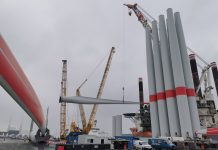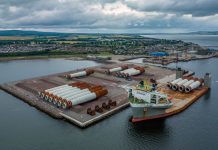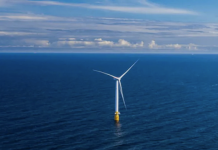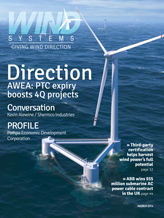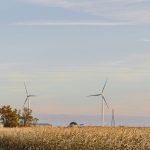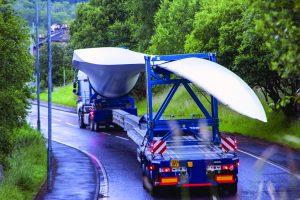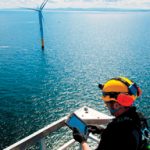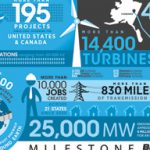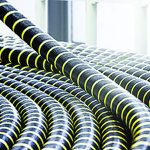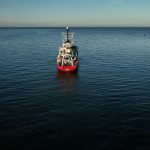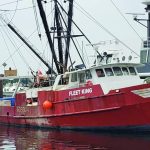The traditional method of installing offshore wind turbines is to assemble the entire three-blade rotor assembly onshore and then use a large ship to install it offshore. Areva, a leader in offshore wind turbines, had the idea of assembling the rotor during the installation which could potentially save about €500 000 ($683,143) per turbine by making it possible to use a smaller ship and crane. The critical question in proving out this new method was determining the loads that would be applied to the blade, tower and locking system while the turbine was in a partially assembled state. Yvan Radovcic, Head of the Loads department, and Edgar Werthen, Mechanical Engineer, for Areva explain how they used SAMCEF Wind Turbines to evaluate many thousands of different load cases to prove the viability of the new method that will potentially save several hundred thousand Euros for future wind turbine installations.
Offshore wind is growing rapidly in the European Union where renewable energy is on track to account for 20 percent of total energy consumption by 2020. Areva has been a player in this segment since 2004 and is one of the top three in offshore wind in Europe. The company has an installed base of more than 120 wind turbines and already has won 600 MW in firm orders for its M5000 5 MW wind turbine. The M5000 technology has been further optimized with the development of a new 135 meter (443 ft.) rotor that sweeps an area 35% larger than the M5000. The first M5000-135 prototype has been installed and commissioned in Germany.
Turbine design challenges
“One of the challenges in designing offshore wind turbines is the high cost and logistical difficulties involved in physical testing,” said Radovcic. “Fully testing a single blade assembly costs several hundred thousand Euros. Physical testing is also limited by the wind and wave conditions that happen to be experienced during the testing period.” Areva has long been working on improving their ability to simulate the performance of wind turbines prior to the prototyping phase in order to evaluate more design alternatives to improve performance and reduce manufacturing and installation costs.
A major difficulty in simulating wind turbines is the range of different physics that must be considered, which typically requires multiple analysis tools. The first main application is assessing the loads on the turbine, which is typically performed with coupled aero-mechanical software. Second is the design of the mechanical components such as the yaw and gearbox, which are typically analyzed with multibody dynamics simulation tools. Third is the structural components such as the bedplate, which are typically analyzed using finite element analysis codes.
It typically takes days or weeks to produce results with each of these different simulation tools. These results are often difficult to integrate with the other tools, which is required in order to fully evaluate the proposed design. Another problem with the use of multiple codes is the need to license, learn and administer each of the different codes.
A new approach captures the complete system in a single model
 AMCEF Wind Turbines from the LMS Samtech solution suite, on the other hand, captures the dynamics of a complete wind turbine in a single model that includes hydrodynamic models for wave loading and aerodynamic models for wind loading, multibody models for evaluating the performance of mechanisms such as the drive train and finite element models for simulating the performance of structural elements. The SAMCEF solver computes the solution in the time domain by direct integration including multi-body dynamics, control systems, aerodynamic and hydrodynamic forces. The simulation tool includes parametric models of wind turbine components such as blades, towers and gearboxes that can be quickly adapted to match a specific design. Users also have the option of modeling components and assemblies from scratch when needed.
AMCEF Wind Turbines from the LMS Samtech solution suite, on the other hand, captures the dynamics of a complete wind turbine in a single model that includes hydrodynamic models for wave loading and aerodynamic models for wind loading, multibody models for evaluating the performance of mechanisms such as the drive train and finite element models for simulating the performance of structural elements. The SAMCEF solver computes the solution in the time domain by direct integration including multi-body dynamics, control systems, aerodynamic and hydrodynamic forces. The simulation tool includes parametric models of wind turbine components such as blades, towers and gearboxes that can be quickly adapted to match a specific design. Users also have the option of modeling components and assemblies from scratch when needed.
Predicting dynamic loads on drivetrains
“The first challenge that we decided to try and address with LMS Samtech was accurately predicting the dynamic loads on drive trains,” Werthen said. Traditionally Areva has used analytical methods to perform static analysis to estimate loads on components such as bearings and gears and the resonant frequencies of the drivetrain. One of the most important cases occurs during a short circuit in the generator. In normal operation, the wind imposes torque on the drivetrain and the generator imposes counter-torque but if there is a short circuit the counter-torque goes away, generating large loads on the drivetrain. These loads cannot be calculated using traditional analytical methods and short circuits are difficult and expensive to evaluate experimentally.
Areva engineers used the multibody simulation features of SAMCEF Wind Turbines to model the complete drive system. “This approach made it possible for the first time to accurately estimate the oscillations that occur when we lose counter-torque in the generator,” Radovcic said.
Validating the one-blade-at-a-time assembly method
“Our next major project involved taking advantage of the global simulation capabilities of the software to explore an improvement to our installation process,” Radovcic said. “The traditional installation method involves assembling all three blades onshore. With this approach a very large ship with a large crane is required to carry and lift the 115 ton blade assembly. Installation makes up 40% of the cost of an offshore turbine so Areva was interested in reducing the cost of the installation process by installing one blade at a time with a smaller ship and a smaller crane. This approach will potentially save several hundred thousand Euros for each wind turbine installed.”
“The challenge in moving to the one blade at a time assembly method is that we have to ensure that the turbine won’t be damaged by high winds and waves with only one or two blades installed.” Werthen said. “The installation process is often delayed due to weather or other factors and in this case the turbine remains in a partially assembled state for up to a month. So before using this installation method it’s essential to ensure that the turbine can withstand a wide range of wind and wave conditions. It would cost well over €1 million ($1,366,288) to address this question with physical testing because we would have to partially assemble the blade, then leave it in place for some period of time in order to determine how it would be loaded by various wind conditions. We would also run the risk of damage to the turbine, which would raise the costs even higher.”
1,000 load cases in 16 hours
Areva used SAMCEF Wind Turbines to model the one-blade-at-a-time installation process with a single blade and with two blades installed. The hydrodynamic model is coupled to a detailed finite element model of the blade and a coarse multi-body dynamics model of balance of the wind turbine. The simulation computes the loads on the blades, tower and locking system.
Wind and wave loading was modeled with SAMCEF’s aerodynamic and hydrodynamic elements that can compute one second of simulation time in about one second of clock time as compared to the traditional CFM method which could easily take a week of clock time to compute a second of simulation time. This higher speed made it possible to simulate thousands of load cases for each phase of the assembly process. Areva runs SAMCEF Wind Turbines on 10 standard personal computers. The simulation software automatically partitions each load case onto a separate processor. The company can run 1,000 load cases in about 16 hours or overnight.
Full control over wind turbine geometry
“Most wind turbine simulation solutions are parametric models that let us control the dimensions but not the geometry of the wind turbine so they cannot be used for modeling the assembly process,” Werthen said. “On the other hand, SAMCEF Wind Turbines gives us full control over the geometry. This feature is essential in modeling wind turbines during various stages of the assembly process. We are also planning to use SAMCEF to check loading on components during transportation.”
“The simulation has proven that the blade, tower and locking system can withstand a wide range of wind and wave loading during the various stages of the one-blade at a time installation process,” Radovcic concluded. “We will soon be performing assembly testing to validate the best approach from a logistical standpoint. Overall, our two years working with LMS Samtech has been a very positive experience. We got up and running quickly and we have had a very good relationship with the development team at LMS Samtech. Whenever we have run into a problem they have solved it for us in a reasonable time frame. In some cases they have even developed features in the main release of the software based on our requests. The software has already far more than paid back the total cost of ownership and we are looking forward to much greater savings in the future.”
For more information, visit www.lmsintl.com.
















